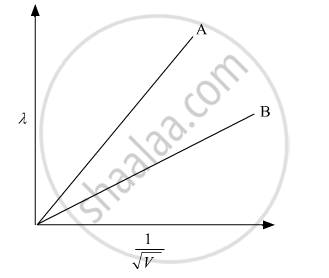Advertisements
Advertisements
प्रश्न
Plot a graph showing variation of de Broglie wavelength λ versus `1/sqrtV` , where V is accelerating potential for two particles A and B, carrying the same charge but different masses m1, m2 (m1 > m2). Which one of the two represents a particle of smaller mass and why?
उत्तर
Given: Charge (q) is the same but masses of both the particles are different (m1 > m2).
The de Brogile wavelength given by
`lambda = h/sqrt(2mqV)`
The slope of the graph λ versus `1/sqrtV `is `h/sqrt(2mq)`

The slope of the smaller mass is larger; therefore, plot A in the above graph is for mass m2
संबंधित प्रश्न
An α-particle and a proton are accelerated through the same potential difference. Find the ratio of their de Broglie wavelength.
Consider the de-Broglie wavelength of an electron and a proton. Which wavelength is smaller if the two particles have (a) the same speed (b) the same momentum (c) the same energy?
Find the de Broglie wavelength of electrons moving with a speed of 7 × 106 ms -1.
Describe in brief what is observed when moving electrons are allowed to fall on a thin graphite film and the emergent beam falls on a fluorescent screen.
Light of wavelength 2000 Å falls on a metal surface of work function 4.2 eV.
What is the kinetic energy (in eV) of the fastest electrons emitted from the surface?
Light of wavelength 2000 Å falls on a metal surface of work function 4.2 eV.
If the same light falls on another surface of work function 6.5 eV, what will be the energy of emitted electrons?
A litre of an ideal gas at 27°C is heated at constant pressure to 297°C. The approximate final volume of the gas is?
A proton is accelerated through one volt the increase in its kinetic energy is approximately
Find the de-Broglie Wavelength for an electron moving at the speed of 5.0 × 106 m/s. (mass of electron is 9.1 × 10-31)
For what k.e of neutron will the associated de-Broglie wavelength be 1.40 × 10-10 m? mass of neutron= 1.675 × 10-27 kg, h = 6.63 × 10-34 J
